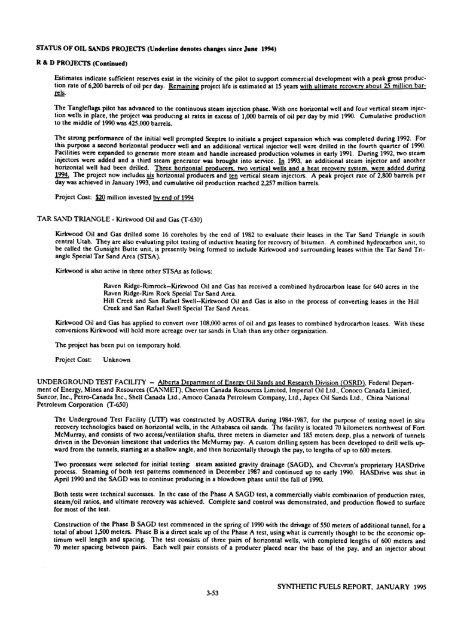Ikelic - Alliance Digital Repository
Ikelic - Alliance Digital Repository
Ikelic - Alliance Digital Repository
Create successful ePaper yourself
Turn your PDF publications into a flip-book with our unique Google optimized e-Paper software.
STATUS OF OIL SANDS PROJECTS (Underline denotes changes since June 1994)<br />
R&D PROJECTS (Continued)<br />
Estimates indicate sufficient reserves exist in the vicinity of the pilot to support commercial development with a peak gross produc<br />
tion rate of 6,200 barrels of oil per day. Remaining project life is estimated at 15 years with ultimate recovery about 25 million bar<br />
rels.<br />
The Tangleflags pilot has advanced to the continuous steam injection phase. With one horizontal well and four vertical steam injec<br />
tion wells in place, the project was producing at rates in excess of 1,000 barrels of oil per mid day by 1990. Cumulative production<br />
to the middle of 1990 was 425,000 barrels.<br />
The strong performance of the initial well prompted Sceptre to initiate a project expansion which was completed during 1992. For<br />
this purpose a second horizontal producer well and an additional vertical injector well were drilled in the fourth quarter of 1990.<br />
Facilities were expanded to generate more steam and handle increased production volumes in early 1991. During 1992, two steam<br />
injectors were added and a third steam generator was brought into service. In 1993, an additional steam injector and another<br />
horizontal well had been drilled. Three horizontal producers, two vertical wells and a heat recovery system, were added during<br />
1994. The project now includes six horizontal producers and ten vertical steam injectors. A peak project rate of 2,800 barrels per<br />
day was achieved in January 1993, and cumulative oil production reached 2,257 million barrels.<br />
Project Cost: $_20 million invested by end of 1994<br />
- TAR SAND TRIANGLE Kirkwood Oil and Gas (T-630)<br />
Kirkwood Oil and Gas drilled some 16 coreholes by the end of 1982 to evaluate their leases in the Tar Sand Triangle in south<br />
central Utah. They are also evaluating pilot testing of inductive heating for recovery of bitumen. A combined hydrocarbon unit, to<br />
be called the Gunsight Butte unit, is presently being formed to include Kirkwood and surrounding leases within the Tar Sand Tri<br />
angle Special Tar Sand Area (STSA).<br />
Kirkwood is also active in three other STSAs as follows:<br />
Raven Ridge-Rimrock-Kirkwood Oil and Gas has received a combined hydrocarbon lease for 640 acres in the<br />
Raven Ridge-Rim Rock Special Tar Sand Area.<br />
Hill Creek and San Rafael Swell-Kirkwood Oil and Gas is also in the process of converting leases in the Hill<br />
Creek and San Rafael Swell Special Tar Sand Areas.<br />
Kirkwood Oil and Gas has applied to convert over 108,000 acres of oil and gas leases to combined hydrocarbon leases. With these<br />
conversions Kirkwood will hold more acreage over tar sands in Utah than any other organization.<br />
The project has been put on temporary hold.<br />
Project Cost: Unknown<br />
- UNDERGROUND TEST FACILITY Alberta Department of Energy Oil Sands and Research Division (OSRD). Federal Depart<br />
ment of Energy, Mines and Resources (CANMET), Chevron Canada Resources Limited, Imperial Oil Ltd., Conoco Canada Limited,<br />
Suncor, Inc., Petro-Canada Inc., Shell Canada Ltd., Amoco Canada Petroleum Company, Ltd., Japex Oil Sands Ltd., China National<br />
Petroleum Corporation (T-650)<br />
The Underground Test Facility (UTF) was constructed by AOSTRA during 1984-1987, for the purpose of testing novel in situ<br />
recovery technologies based on horizontal wells, in the Athabasca oil sands. The facility is located 70 kilometers northwest of Fort<br />
McMurray, and consists of two access/ventilation shafts, three meters in diameter and 185 meters deep, plus a network of tunnels<br />
driven in the Devonian limestone that underlies the McMurray pay. A custom drilling system has been developed to drill wells up<br />
ward from the tunnels, starting at a shallow angle, and then horizontally through the pay, to lengths of up to 600 meters.<br />
Two processes were selected for initial testing: steam assisted gravity drainage (SAGD), and Chevron's proprietary HASDrive<br />
process. Steaming of both test patterns commenced in December 1987 and continued up to early 1990. HASDrive was shut in<br />
April 1990 and the SAGD was to continue producing in a blowdown phase until the fall of 1990.<br />
Both tests were technical successes. In the case of the Phase A SAGD test, a commercially viable combination of production rates,<br />
steam/oil ratios, and ultimate recovery was achieved. Complete sand control was demonstrated, and production flowed to surface<br />
for most of the test.<br />
Construction of the Phase B SAGD test commenced in the spring of 1990 with the drivage of 550 meters of additional tunnel, for a<br />
total of about 1,500 meters. Phase B is a direct scale up of the Phase A test, using what is currently thought to be the economic op<br />
timum well length and spacing. The test consists of three pairs of horizontal wells, with completed lengths of 600 meters and<br />
70 meter spacing between pairs. Each well pair consists of a producer placed near the base of the pay, and an injector about<br />
3-53<br />
SYNTHETIC FUELS REPORT, JANUARY 1995















![pace SrntfletIc fne]its report - Alliance Digital Repository](https://img.yumpu.com/10493335/1/190x245/pace-srntfletic-fneits-report-alliance-digital-repository.jpg?quality=85)
